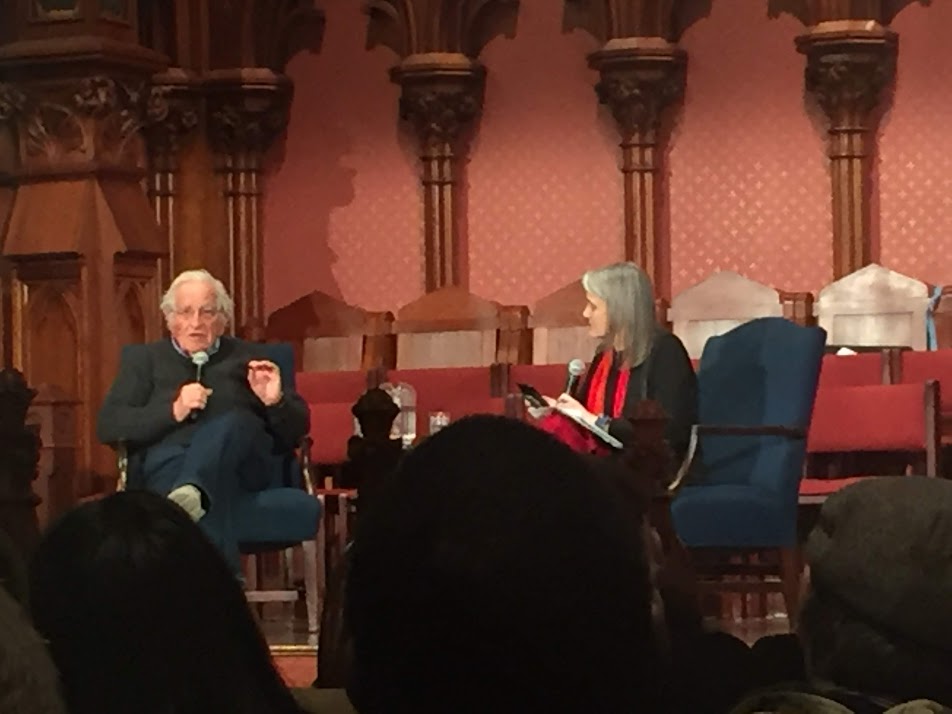—presented by Paolo Marini May 3rd 2021
Noam Chomsky, one of the most important intellectuals alive today, has elaborated the list of the 10 strategies of manipulation through mass media. Take 5 minutes and you won’t regret it. If only to expand your knowledge.
1. The strategy of distraction

Noam Chomsky with Amy Goodman at the Old South Church in Boston on April 11th 2019. —photo Tanbou
The primary element of social control is the strategy of distraction that consists in diverting the public’s attention from important problems and changes decided by political and economic elites, through the flood technique or floods of constant distractions and meaningless information.
Distraction strategy is also indispensable to prevent the public from being interested in essential knowledge, in the areas of science, economics, psychology, neurobiology and cybernetics. Keeping the public’s attention deviated from the real social problems, imprisoned by topics of no real importance.
Keeping the public busy, busy, busy, with no time to think, back to the farm like the other animals (quoted in “Silent weapons for peaceful wars”).
2. Create problems and then offer solutions
This method is also called “problem- reaction- solution”. A problem is created, a “situation” intended to cause a certain reaction from the public, with the aim that this is the mandate of the measures they want to be accepted. For example: letting urban violence be rampant or intensified, or staging bloody attacks, in order that the public is the one demanding security laws and policies at the expense of liberty. Or also: create an economic crisis to make the regression of social rights and the dismantling of public services accepted as a necessary evil.
3. The strategy of graduality
To get an unacceptable measure accepted, you just need to apply it step by step, with droplets, for consecutive years. This is how radically new socio-economic conditions (neoliberalism) were imposed during the decades of the ’80s and ’90s: Minimum state, privatization, precariousness, flexibility, mass unemployment, wages that no longer guarantee decent salaries, many changes that would have caused a revolution if they were applied at once.
4. The strategy of deferring
Another way to get an unpopular decision accepted is to present it as “painful and necessary,” gaining public acceptance, for the time being, for a future application. It is easier to accept a future sacrifice than an immediate sacrifice. First, because the effort isn’t what’s put in immediately. Second, because the audience, the masses, always tend to naively hope that “everything will be better tomorrow” and that the required sacrifice could be avoided. This gives the audience more time to get used to the idea of change and accept it resigned when the time comes.
5. Addressing the audience like children
Most advertising directed at the general public uses speeches, topics, characters and a particularly childish intonation, often close to weakness, as if the viewer were a creature of few years or a moron… The more you try to deceive the viewer, the more you tend to use a childish tone. Why? “If someone refers to a person as if they were 12 years old or younger, then, based on suggestability, they will tend, with some probability, to a response or reaction that is also of a person 12 years old or less.” (See “Silent weapons for peaceful wars”).
6. Use the emotional aspect much more than reflection
Take advantage of emotion is a classic technique to provoke a short circuit on rational analysis and, finally, the individual’s critical sense. In addition, using the emotional register allows you to open the door to the unconscious to implant or inject ideas, desires, fears and fears, compulsions, or induce behaviors.
7. Keeping the audience in ignorance and mediocrity
Making the public unable to understand the technologies and methods used for their control and slavery. “The quality of education given to the lower social classes must be the poorest and mediocre possible, so that the distance of ignorance that they plan between the lower and the upper classes will remain impossible to fill by the lower classes”.
8. Encourage the audience to be complacent with mediocrity
Pushing the audience into believing it’s trendy to be stupid, vulgar and ignorant…
9. Strengthening self-guilt
Making the individual believe that he is the only one to blame for his misfortune, because of his insufficient intelligence, ability or effort. Thus, instead of rebelling against the economic system, the individual self devalues and blames himself, which in turn creates a depressive state, one of which effects is the inhibition of his action. And without action there is no revolution!
10. Knowing individuals better than they know themselves
Over the past 50 years, science’s rapid advances have caused a growing gap between the public’s knowledge and those owned and used by the dominant elites. Thanks to biology, neurobiology, and applied psychology, the “system” has enjoyed an advanced knowledge of the human being, both in its physical and psychological form. The system has managed to know the common individual better than he knows himself. This means that, in most cases, the system exercises greater control and power over individuals, greater than that individual exercises over himself.
